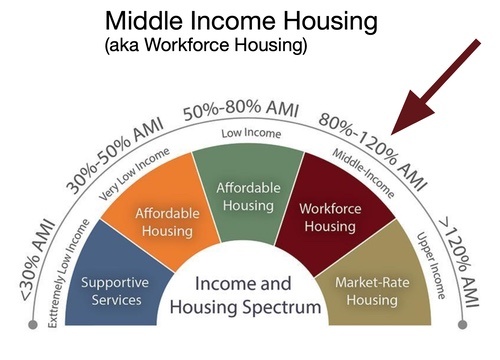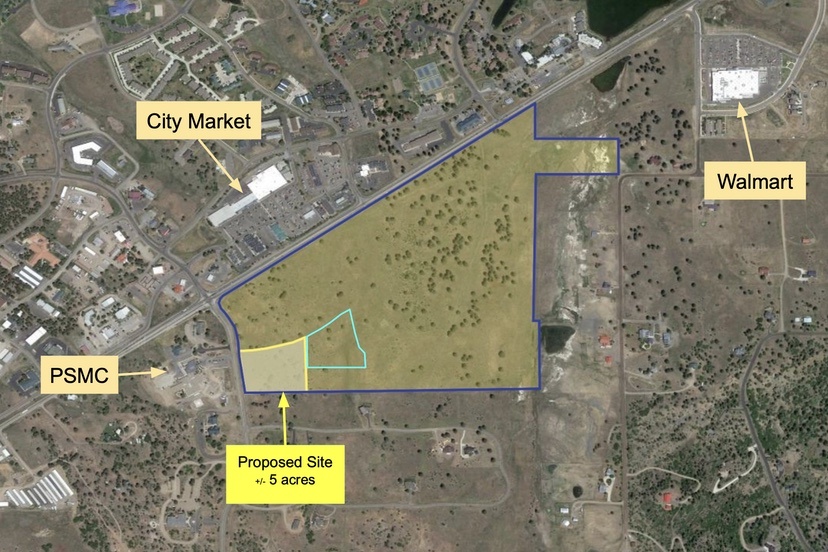Image: A map shared by Colorado Outdoors LLC, as part of an effort to get the Archuleta Board of County Commissioners purchase a vacant parcel near the Pagosa Springs Medical Center for $2.1 million.
On Saturday, I attended a public presentation at the Ruby Sisson Library, to hear local activist Rachel Suh discuss the recall petition currently circulating in Archuleta County. The petition would allow the community to vote on the possible recall of Archuleta County Commissioner Veronica Medina for allegedly violating several Colorado statutes.
Commissioner Medina attended the presentation, to answer audience questions and defend her position that she did not, in fact, violate government ethics or the law.
I’ve been referencing, in this editorial series, the proposal by Commissioner Medina and her fellow commissioners to purchase perhaps five acres from the development company known as ‘Colorado Outdoors LLC’ at a price of $10 per square foot — a relatively high price, I’ve been told by a couple of local realtors — and because the alleged violations by Commissioner Medina are directly related to that proposed County purchase, the discussion on Saturday centered around Ms. Medina’s June 4vote in favor of pursuing this real estate purchase.
The parcel in question is being brokered by Shelley Low of EXIT Realty, for whom Ms. Medina works as a contracted real estate agent.
We will consider that public presentation tomorrow in some detail. But this morning I’ll share one comment by Commissioner Medina. She was asked by an audience member, “So I’m going to accept that you aren’t getting any [financial gain] from this… but I’m still trying to figure out why the commissioners are leaning toward that property over the other property. Why that property?”
Commissioner Medina responded: “Workforce housing. Because, workforce housing… more housing in our community has been a long-time issue. This is just a different way that the County can assist, and be an anchor property, so the developer can apply for more grants through the state.”
We don’t know why our other two County commissioners — Warren Brown and Ronnie Maez — also voted to move forward with drafting a $2.1 million purchase agreement with Colorado Outdoors developers David, Heidi and Doug Dragoo. But apparently, “housing” was Commissioner Medina’s motivation for using County tax revenues to purchase what appears to be overpriced vacant land… because this will presumably make it easier for Colorado Outdoors to obtain state grants, and perhaps make a larger profit building what they are calling “workforce housing”.
I currently volunteer on the Pagosa Area Water and Sanitation District (PAWSD) board of directors, and our board has been supportive of workforce housing projects, by reducing certain fees in situations where a developer is willing to place deed restrictions on the project to keep the dwelling units “affordable”.
Disclosure: This article reflects only my own opinions, and not necessarily the opinions of other PAWSD board members or PAWSD staff.
Of course, what is “affordable” to a typical worker in Pagosa Springs is not the same thing as what’s “affordable” to a retired couple who just sold a house in San Diego.
Ultimately, the money for any PAWSD subsidies ultimately comes from the PAWSD customers. So the PAWSD board, thus far, has drawn a line at 80% Area Median Income, with subsidies up to 100% AMI only in special circumstances.
When governments start subsidizing housing for people earning 120% AMI or 140% AMI, they are actually providing entitlements to people who have a significantly higher income than the majority of our workforce. But these wealthier workers appear to be the demographic group Colorado Outdoors and Commissioner Medina will be serving, because when a developer is provided a range of AMI levels like “80% – 120%”…

…the most profit will be generated by serving the higher end of that range… housing for households at the “120%” level. We’ve often heard developers whine that it’s “too hard” to build homes in the 80% AMI range. That it “doesn’t pencil”.
Developers sometimes use phrases like “middle income” and “missing middle” to disguise the fact that they are actually serving higher income households. That’s where the most profit is, and in modern America, profit is generally the name of the game.
In an editorial a few months back, I shared a video about communities working together.
On May 13, 2014, about 40 Amish farmers gathered at a building site in Ohio to raise a massive barn. While the men — the sons and fathers — assembled the barn, the sisters and mothers worked in tandem to prepare a delicious lunch and dinner for everyone to share. The barn-raising took about 10 hours.
Here’s a YouTube video that compresses that 10-hour event into 3 minutes, 30 seconds:
This kind of thing doesn’t generally happen in Pagosa Springs, when it comes to homes, and barns. We do have volunteer organizations to handle certain types of services, but we generally expect a for-profit company like Colorado Outdoors to end up with a nice profit in their bank account, even if they’re building something called “workforce housing”…
…”Profit” being the excess money collected after you’ve paid for all your materials, equipment, employees and taxes. “Profit” is money “earned” by the company’s owners — not necessarily for actual labor performed, but rather, because they control the company.
Businesses aren’t always operated “for profit”. Many of the most valuable services in Pagosa Springs are provided by “non-profit” entities. These include our local governments — the Town, the County, PAWSD, Sisson Library, Archuleta School District, Pagosa Springs Medical Center, the Fire District — and non-profit corporation like Rise Above Violence, Habitat for Humanity, Seeds of Learning, Vets for Vets, and the Chimney Rock Interpretive Association.
These organizations are prohibited by law from generating “profit” for select individuals. Legally, all their revenues must be used to provide services to their constituents. That includes paying employees, but does not include paying dividends to shareholders.
Colorado law prohibits a government official from taking actions and making decisions that will benefit a business owned by the official or by one of the official’s family members… or a business with which the official has a contractual relationship.
Commissioner Veronica Medina has a contractual relationship with EXIT Realty.

Nevertheless, Commissioner Medina — in a public meeting on June 4 — argued in favor of the County’s purchase of a $2.1 million property being marketed by EXIT Realty, and voted to direct County staff to create a purchase agreement for that property.
This was, in my opinion, not only a violation of government ethics, but also a violation of Colorado law.
An honest mistake? If so, can we get an apology?

